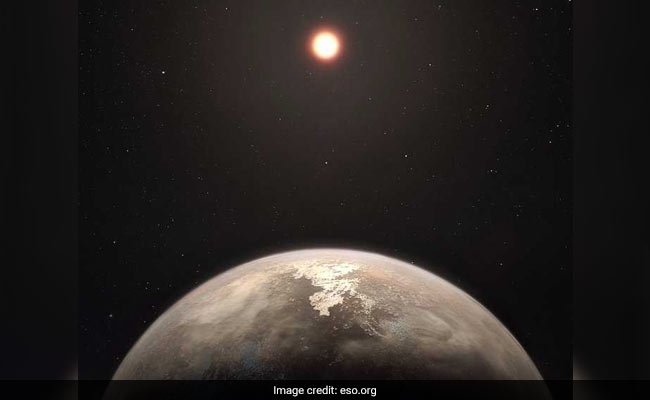
The newfound world, dubbed Ross 128 b, is the closest temperate planet (Representational)
Quick Take
Summary is AI generated, newsroom reviewed.
The newfound planet has been named Ross 128 b
It is the closest temperate planet to Earth known to orbit a 'quiet star'
The planet meets some of the basic requirements for habitability
Writing in the journal Astronomy and Astrophysics, scientists report the discovery of an Earth-size exoplanet orbiting the star Ross 128, a dim red dwarf just 11 light-years away.
The newfound world, dubbed Ross 128 b, is the closest temperate planet known to orbit a "quiet star" - one that isn't prone to devastating and potentially life-obliterating bursts of radiation.
And it appears to meet some of the basic requirements for habitability. The planet is slightly more massive than Earth, so it is probably a rocky world with a solid surface. The host star is much cooler and fainter than our sun, but Ross 128 b orbits it closely and quickly - a year lasts just 9.9 days. The planet receives about 38 percent more radiation than Earth does - enough to give it an equilibrium temperature between -76 and 68 degrees Fahrenheit, assuming it has an Earthlike atmosphere (and that's a huge assumption).
Though the study authors call Ross 128 b a "temperate planet," it's not clear whether it falls within the habitable zone - the Goldilocks region where a planet is just warm enough for liquid water to exist on its surface.
Additionally, no current telescopes are capable of analyzing the wavelengths of light coming from the planet, which might provide clues about the existence of an atmosphere and the potential for life. But when the powerful 39-meter Extremely Large Telescope comes online in 2024, this world will be one of its first targets.
Ross 128 b is not Earth's nearest extrasolar neighbor. The exoplanet Proxima b, which orbits the star next door to our sun, is even closer than Ross 128 b - just 4.2 light-years away. But its host star, a red dwarf called Proxima Centauri, has been compared to a hormonal teenager. It produces violent flares of radiation that can strip away an atmosphere and sterilize a planet. You would not be a happy camper if you lived in the vicinity.
Ross 128 is more like a 30-something with a good job, a membership in a yoga studio and an extensive collection of James Taylor albums. You could probably trust it not to fry its own planet.
Indeed, Ross 128 is so agreeable that it's actually heading toward us. According to Nicola Astudillo-Defru, an astronomer at the University of Geneva and co-author of the study, the star's orbit through the galaxy has put it on a path toward Earth. In 71,000 years, it will become our closest neighbor, and Ross 128 will be the closest temperate planet.

The artist's impression shows the planet Ross 128 b, with its red dwarf parent star in the background
All this wobbling affects the radiation these stars emit: The light changes frequency, much the way a sound changes pitch when its source is moving - a phenomenon known as the Doppler Effect.
Using this technique, the scientists at La Silla sorted through night after night of observations of the star Ross 128, looking for evidence of a Doppler effect. After capturing the star at more than 150 points in time, they determined that they had enough evidence to confirm the presence of a planet.
Noting that this is just the latest exoplanet discovery of thousands, Astudillo-Defru acknowledged that this one "may feel like one more among others." But no other exoplanet known to science is as close and as seemingly hospitable as Ross 128 b.
"This one is special," Astudillo-Defru added.
To date, NASA's Exoplanet Archive includes 3,550 confirmed alien worlds: tremendous "Hot Jupiters" that orbit close to their suns; hellish planets whose surfaces are as hot as a star's; bodies so compacted that their carbon is crushed into a diamond; "rogue" globes of gas that roam through the galaxy not bound to any star. There are even millions of "Earth twins" - worlds that, from a distance, look not unlike our own.
But at times, that catalogue can feel like a travel guide to lands we'll never see. Scientists seldom observe exoplanets directly - instead, they intuit the bodies' existence based on tiny fluctuations in the light coming from distant stars. And given the vast distances involved in interstellar travel, no Earthling has a hope of visiting most of these places.
That's true even of Ross 128 b. Eleven light-years might be a skip and a jump in cosmic terms, but it is still far greater than any expanse any human has traversed. For comparison, the moon - still the most distant destination visited by people - is a mere 1.3 light-seconds away.
Still, it's hard to argue with Astudillo-Defru. Vast and impenetrable though the universe may be, now we know it harbors at least one friendly neighbor. There's something special about that.
(This story has not been edited by NDTV staff and is auto-generated from a syndicated feed.)
Track Latest News Live on NDTV.com and get news updates from India and around the world

